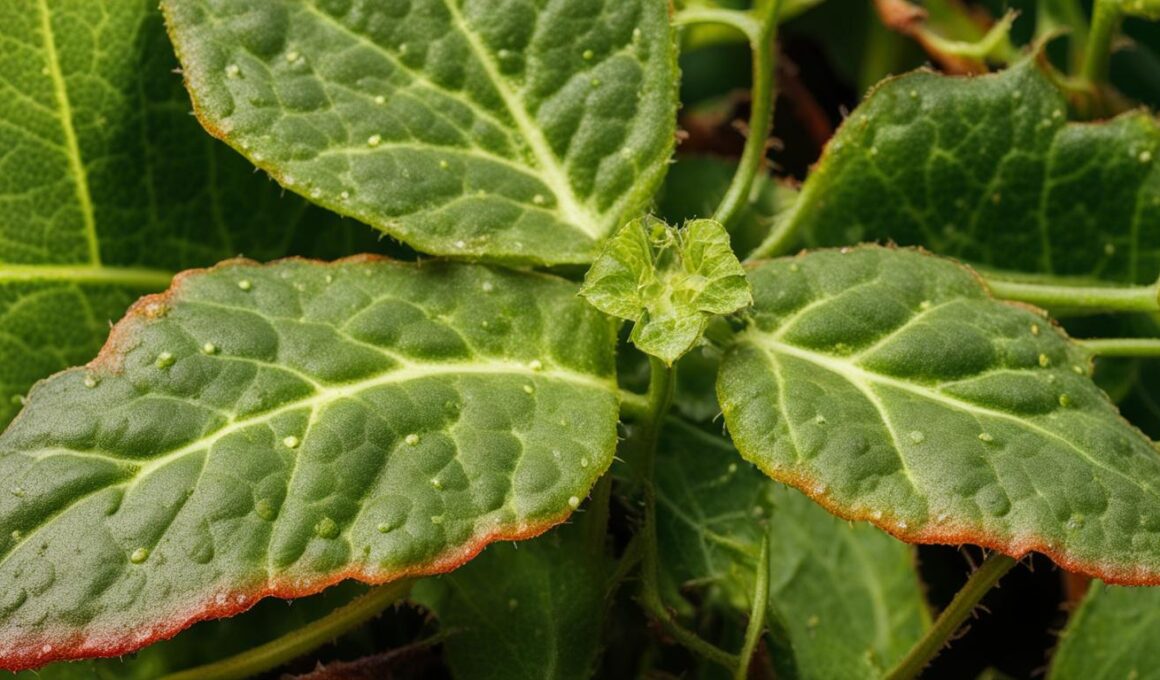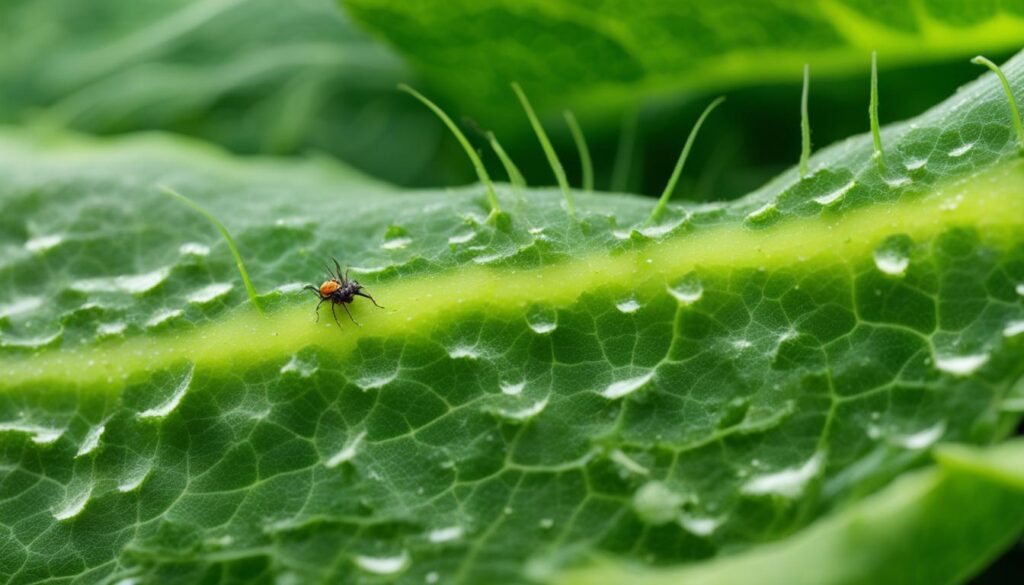Spider mites can wreak havoc on your cucumber plants. These tiny sucking pests, although not true insects but arachnids, form colonies on the underside of leaves. They feed by piercing leaf tissue and sucking up plant fluids. Spider mites are most common in hot, dry conditions, especially when their natural enemies have been killed off by insecticide use.
In this section, we will discuss how to identify and prevent spider mite damage and provide effective ways to eliminate spider mites from your cucumber plants. Let’s get started!
Key Takeaways:
- Spider mites are arachnids that live in colonies on the underside of cucumber plant leaves.
- They feed by piercing leaf tissue and sucking up plant fluids.
- Spider mites can cause yellowing, drying, and leaf drop in cucumber plants.
- Preventing spider mite infestations include regular plant inspections, proper watering, and releasing beneficial insects.
- Natural methods such as pruning infested parts, using horticultural oils, and insecticidal soaps can help control spider mites.
What are Spider Mites?
Spider mites are common pests in gardens and are not true insects but arachnids. There are many species of spider mites, with the two-spotted spider mite and red spider mite being the most common in the United States. They are smaller than the head of a pin and have eight legs. Spider mites live in colonies on the underside of leaves and feed by piercing leaf tissue and sucking up plant fluids. They can cause yellowing and drying of leaves and can be especially destructive in greenhouses.
Spider mites can infest both indoor and outdoor plants, making them a nuisance for gardeners and horticulturists alike. They thrive in hot, dry conditions, which is why they are most common during the summer months. Spider mites reproduce rapidly, with females laying hundreds of eggs within a short period of time. This rapid reproduction, combined with their ability to quickly adapt to different environments, makes them a challenging pest to control.
“Spider mites are tiny pests that can quickly wreak havoc on your plants. They may be small, but their impact can be significant, causing leaves to yellow, dry out, and eventually fall off. It’s important to identify spider mite infestations early on and take prompt action to prevent further damage.”
To effectively manage spider mite infestations, it is essential to understand their behavior and life cycle. In the next section, we will dive deeper into the life cycle of spider mites and explore strategies to spot and prevent their damage.
Life Cycle of Spider Mites
Understanding the life cycle of spider mites is crucial for effectively combating these pests. Spider mites go through several stages of development from eggs to nymphs and finally to adult mites. This life cycle can occur in as little as five days, especially in hot and dry weather conditions.
The life cycle of spider mites begins with overwintering eggs that hatch in the spring. The tiny larvae that emerge feed for a few days before molting into the first nymphal stage. The nymphs go through two more molts, becoming larger and more destructive with each stage, before reaching adulthood. Females can lay up to 300 eggs over a couple of weeks, leading to several overlapping generations per year.
Understanding the different life stages of spider mites is essential for implementing effective control measures. By targeting the eggs, nymphs, and adults throughout their life cycle, you can interrupt their reproductive process and greatly reduce their population.
Damage Caused by Spider Mites
Spider mites can wreak havoc on your cucumber plants, causing significant damage that can impact both their appearance and productivity. These tiny pests feed on the sap from plant cells on the underside of leaves, resulting in small yellow spots or stipplings. Over time, the leaves may change color, curl, and eventually fall off. Infested plants may also develop fine webbing as the mites create a protective shelter for themselves.
Spider mite damage can be especially detrimental for annual vegetable crops and can directly harm crops like sugar peas and beans. While ornamental plants may not suffer significant yield loss, spider mites can still cause aesthetic concerns and potential plant death if their populations become very high. It’s important to be proactive in preventing and controlling spider mites on your cucumber plants to ensure their health and productivity.
“Spider mite damage can significantly impact the appearance and yield of your cucumber plants. It’s important to address the issue promptly to prevent further damage to your crops.”
By regularly inspecting your plants and being vigilant for signs of spider mite damage, you can catch infestations early and take necessary action. This includes checking the undersides of leaves for webbing or mites, as well as being aware of any yellow spots or stipplings on the leaves. Taking immediate steps to address spider mite infestations, such as isolating and removing heavily-infested plants, can help prevent the spread of these pests and minimize the damage they cause.
Implementing preventative strategies can also help in reducing spider mite damage. Proper watering is crucial to avoid water stress in plants, as spider mites thrive in hot, dry conditions. Pruning infested parts of the plants and spraying them with water can also help reduce spider mite populations. Additionally, releasing beneficial insects like ladybugs and lacewing can provide natural control of spider mites.
How to Spot and Prevent Spider Mite Damage
To effectively combat spider mite infestations on your cucumber plants, it’s crucial to be able to spot the initial signs of damage. Regularly inspect your plants for leaves with white or yellow spots, as these are often indications of spider mite feeding. Take a closer look at the undersides of the leaves, where you may find webbing or even the mites themselves.
If you discover spider mites on a plant, it’s important to take immediate action to prevent the infestation from spreading. Isolating the infested plant can help contain the problem. In severe cases, where the infestation is extensive, it may become necessary to remove heavily-infested plants altogether.
Prevention Strategies
- Prune infested parts: If you notice signs of spider mite damage on specific parts of a plant, carefully prune those areas to remove the infestation.
- Proper watering: Spider mites thrive in dry conditions, so it’s essential to water your cucumber plants adequately. This will reduce water stress and make the environment less favorable for these pests.
- Spray plants with water: Regularly spraying your plants with water can help reduce spider mite populations. The force of the water can dislodge the mites and wash away their eggs.
- Release beneficial insects: Ladybugs and lacewings are natural predators of spider mites. Introducing these beneficial insects into your garden can help control the population of spider mites.
Additionally, horticultural oils and insecticidal soaps can be effective for spot treatment of spider mite infestations. These products suffocate the mites and disrupt their life cycle. However, it’s essential to use them with caution, following the instructions carefully to avoid harming beneficial insects and other wildlife in your garden.
How to Control and Get Rid of Spider Mites
When it comes to dealing with spider mites, natural methods are often the most effective and eco-friendly. Chemical pesticides can actually worsen the problem and lead to resistance in spider mites. Here are some proven strategies to control and eliminate spider mites from your cucumber plants:
- Pruning infested parts: If you spot any heavily infested leaves or plants, promptly remove and dispose of them. This will help contain the spread of spider mites and prevent further damage.
- Proper watering: Spider mites thrive in hot, dry conditions. By ensuring that your cucumber plants receive adequate moisture, you can significantly reduce their stress levels and make the environment less favorable for spider mites.
- Spraying with water: Regularly spraying your cucumber plants with a strong jet of water can help dislodge and wash away spider mites. Focus on the undersides of leaves where they tend to gather.
- Releasing beneficial insects: Ladybugs and lacewing are natural predators of spider mites. Introducing these beneficial insects to your garden can help keep the mite population in check. You can purchase them from garden centers or order them online.
- Horticultural oils and insecticidal soaps: These natural products can be effective in controlling spider mites. They work by suffocating the mites and disrupting their reproductive cycle. Apply them according to the instructions on the product label.
If the infestation is severe or the natural methods don’t provide satisfactory results, you may consider using least-toxic pesticides. However, it’s important to remember that pesticides should be the last resort and only used when absolutely necessary. Always choose environmentally friendly options and follow the instructions carefully. Remember to repeat the treatments as needed, especially during warm weather when spider mites are most active and continuously laying eggs.
By implementing these control methods and being proactive in monitoring your cucumber plants, you can effectively combat spider mite infestations and protect the health and productivity of your garden.
Conclusion
By implementing effective spider mite prevention and control strategies, you can protect your cucumber plants from the devastating damage caused by these pests. Regularly inspect your plants for signs of infestation, such as yellow spots, leaf discoloration, and webbing on the underside of leaves. Isolate any infested plants to prevent the spread of mites to other healthy plants.
Prevention is key to keeping spider mites at bay. Prune any infested parts of the plant and ensure proper watering to reduce water stress, as spider mites thrive in hot and dry conditions. Consider using a strong jet of water to spray the plants, which can help dislodge and reduce mite populations. Additionally, releasing beneficial insects like ladybugs and lacewing can provide natural control.
Avoid resorting to chemical pesticides as they can harm the environment and beneficial insects. Instead, opt for natural methods such as horticultural oils and insecticidal soaps. Neem oil can be particularly effective in disrupting the reproductive cycle of spider mites. When infestations are severe, use least-toxic pesticides to reduce mite populations before introducing predatory mites.
By following these guidelines and staying vigilant, you can successfully combat spider mites on your cucumber plants. Remember, early detection and proactive prevention are key to maintaining the health and productivity of your garden.
-Can Lemongrass also help in repelling spider mites on cucumber plants?
Yes, the lemongrass bee repellent truth is that it can also help in repelling spider mites on cucumber plants. Lemongrass contains citronella, which is known for its insect-repelling properties. Simply planting lemongrass near your cucumber plants can help keep spider mites at bay.
FAQ
What are spider mites?
Spider mites are tiny arachnids that feed on plant fluids by piercing leaf tissue. They are not true insects but arachnids.
How can I identify spider mite damage?
Look for yellow spots or stipplings on the leaves, webbing on the underside of leaves, and leaves that change color, curl, or fall off.
What can I do to prevent spider mite damage?
Prune infested parts, properly water the plants, spray plants with water to reduce pest numbers, release beneficial insects, and use horticultural oils and insecticidal soaps for spot treatment.
Can I use chemical pesticides to control spider mites?
Chemical pesticides can actually encourage the spread of spider mites and lead to resistance. It is recommended to use natural methods such as pruning, proper watering, and releasing beneficial insects.
How long does it take for spider mites to develop from eggs to adults?
The development from egg to adult can occur in as little as 5 days, especially in hot, dry weather.
How can I get rid of a severe spider mite infestation?
If infestation is severe, removing heavily-infested plants may be necessary. Least-toxic pesticides can be used to reduce infestations before releasing predatory mites to maintain control.












